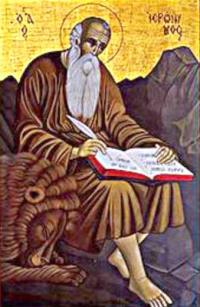
St Jerome (c.347 - 420)
Feast day: 30 September
Eusebius Hieronymus, known to us as St Jerome, was born in about 347 in Stridon in the Roman province of Dalmatia (the area of modern Croatia). He came from a Christian family sufficiently prosperous to send the highly intelligent boy to Rome to receive the best education money could buy, the classical training of the élite of the Roman world. Such ability and education would normally have led to a career in the imperial service and entry into the governing classes. Perhaps with this in mind, his schooling over, Jerome and a friend journeyed to Trier, in Gaul, an important government centre. There Jerome underwent some sort of religious awakening which caused him to give up his worldly ambitions and dedicate himself to a more committed Christian life, a celibate, ascetic life following the ideals of early monasticism recently brought to the West from the Middle East.
He spent some time in the Greek-speaking East, in Antioch, where he perfected his command of Greek, followed by a sojourn in the Syrian desert, where he lived the harsh life of an anchoritic monk and immersed himself in the reading and study of the Bible, using all the tools with which his Classical education had equipped him. He also began to study Hebrew, a decision unusual at this time, which had enormous consequences for himself and the course of Biblical scholarship.
Complex ecclesiastical affairs brought him to the eastern capital, Constantinople, after which St Jerome returned to Rome, where he came to the attention of Pope Damasus, for whom he acted in some sort of secretarial capacity. Most importantly for posterity, at the Pope’s urgent request he produced a new Latin translation of the Gospels from the Greek original, since the existing Latin versions were full of mistakes and of very poor quality. This was the start of St Jerome’s work of Biblical translation which was to occupy him, on and off, for the rest of his life.
His advocacy of the ascetic life and his biblical expertise attracted a following of upper-class Roman women who were attempting to live an ascetic, monastic life in their own homes, and for whom he acted as biblical teacher and spiritual advisor. Among these were the aristocratic Paula and her daughter, Eustochium.
After the death of Pope Damasus, Jerome fell out of favour in Rome. He travelled to Bethlehem where he established a monastery for men near the Church of the Nativity. He was joined there by Paula and Eustochium and with them founded a monastery for women and a hospice for pilgrims. He spent the remaining 33 years or so of his life in Bethlehem supervising the monasteries, studying and writing. The vast and varied work he produced during these years was done against a backdrop of major theological controversy and a disintegrating western Roman world. He and his colleagues struggled to provide food and shelter for desperate refugees who came flooding into the Holy Land from the Gothic invasions of Italy. Near the end of his life the monasteries in Bethlehem were raided and burned, possibly by fanatical theological opponents. He continued to work and write when he could despite the probable lack of a permanent home and repeated illness. He died in Bethlehem some time in 420.
St Jerome is honoured for the huge legacy of writings he left to the Church, an output exceeded only by his younger contemporary St. Augustine. In addition to his translations of Scripture he produced many commentaries on books of the Bible. He was an eloquent and passionate advocate of the world-renouncing ascetism which he believed was inculcated by the gospel. He was also a ferocious polemicist wherever his views were challenged or heresy arose, and a prolific letter-writer, whose surviving correspondence reveals a large web of contacts across the world. But his greatest achievement, from our point of view, was the laborious, painstaking, scholarly translation into Latin of many books of the Bible.
His work on the Old Testament came at great personal cost. The early Church read its Old Testament in Greek, the version known as the Septuagint. Translations from this into Latin for the Greekless majority were necessary but were produced piecemeal and much was of extremely poor quality. When St Jerome embarked on the huge task of making the Scriptures more available to his own Latin-speaking people by giving them good, accurate translations, he became convinced, as a scholar, that he should not translate from a translation but should go back to ‘The Hebrew verity’. This met with great opposition. People were suspicious, preferring the versions they were used to, and the Septuagint was considered to be inspired. It was a long time before his work gained complete acceptance by the Church, but eventually his translations became the core of the Latin Bible known as The Vulgate (Common) Edition.
This, then, was St Jerome’s legacy, his gift of inestimable value: an accurate, scholarly Latin translation of the Scriptures, which served the western Church for more than a thousand years and laid the foundation for future Bible study in the west. In the 8th century he was acclaimed, together with Ss Ambrose, Augustine and Gregory, as one of the four great Doctors of the Church. His works were widely read and very influential in the Middle Ages, and he is honoured as the patron of students, translators and librarians.